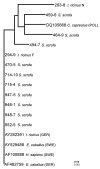Wild boars as hosts of human-pathogenic Anaplasma phagocytophilum variants
- PMID: 22607827
- PMCID: PMC3358146
- DOI: 10.3201/eid1806.110997
Wild boars as hosts of human-pathogenic Anaplasma phagocytophilum variants
Abstract
To investigate the potential of wild boars to host Anaplasma phagocytophilum, we analyzed bacterial 16S rRNA and ank genes. DNA sequencing identified several A. phagocytophilum variants, including a predominance of strains known to cause human disease. Boars are thus hosts for A. phagocytophilum, notably, strains associated with human granulocytic anaplasmosis.
Figures


Comment in
-
Wild Boars as Hosts of Human-Pathogenic Anaplasma phagocytophilum Variants.Emerg Infect Dis. 2012 Dec;18(12):2094-5. doi: 10.3201/eid1812.120778. Emerg Infect Dis. 2012. PMID: 23171572 Free PMC article. No abstract available.
References
-
- Johansson K-E, Pettersson B, Uhle’n M, Gunnarsson A, Malmqvist M, Olsson E. Identification of the causative agent of granulocytic ehrlichiosis in Swedish dogs and horses by direct solid phase sequencing of PCR products from the 16S rRNA gene. Res Vet Sci. 1995;58:109–12. 10.1016/0034-5288(95)90061-6 - DOI - PubMed
Publication types
MeSH terms
Substances
LinkOut - more resources
Full Text Sources
Molecular Biology Databases
